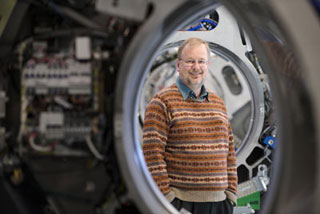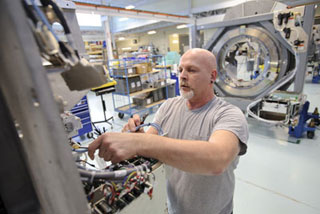TomoTherapy sold, but medical physics spinoffs continue to benefit Wisconsin
The announcement March 7 that TomoTherapy Inc., a Madison producer of sophisticated cancer treatment equipment, was sold to Accuray, a California maker of equipment for radiation surgery, spotlights the economic impact of the Department of Medical Physics at the University of Wisconsin–Madison.

Thomas “Rock” Mackie stands with gantries for medical radiation therapy equipment being assembled at TomoTherapy’s manufacturing facility in Madison, Wis., on Feb. 21, 2011.
Photo: Jeff Miller
TomoTherapy, with 350 employees in Madison and 650 total, was the latest success story for an academic department that has made major scientific advances in MR (magnetic resonance imaging), CT (computed tomography scanning) and the detection of heart and artery disease.
TomoTherapy makes machines, now used in more than 300 clinics worldwide, that deliver precise doses of radiation to tumors while allowing physicians to monitor treatment with a built-in CT scanner. The ultra-precise targeting kills the tumor more effectively and reduces side effects.
Even with the new ownership the manufacturing end of the business will stay in Madison.
The TomoTherapy sale, valued at about $277 million, “made a lot of sense for patients, shareholders, customers and the employees,” says company co-founder Thomas “Rock” Mackie, a professor of medical physics. “Ultimately it’s going to be more than twice the size, it will have bigger presence in the market and reduced overhead.”
Even with the new ownership, Mackie says, the manufacturing end of the business will stay in Madison.
“Testing requires huge bunkers [for radiation shielding] and would be physically impossible to move. As for design and engineering, that will be up to the new company to decide,” he says.

Assembly technician Ken Harlson installs electrical components on a medical radiation therapy unit.
Photo: Jeff Miller
As Wisconsin confronts a continuing unemployment crisis and struggles to create manufacturing jobs, the department has spawned businesses to treat cancer, detect osteoporosis, ensure radiation safety and improve the detail on medical images. UW–Madison medical-physics inventions are being used to diagnose and treat patients around the world.
Many inventions have been licensed to the giants of medical electronics: GE Healthcare, Siemens and Philips Electronics. As TomoTherapy shows, some of the most successful spinoffs have been sold.
The hundreds or thousands of Wisconsin jobs that the department has created reflect the university’s longstanding expertise in medicine, radiation and physics, as well as the explosion in the use of radiation for diagnosis and treatment.
Since the department was formed in 1980, medical physics, a branch of the School of Medicine and Public Health, has grown into a department with 30 faculty members, 27 academic staff, and 134 graduate or postdoctoral students. The successes include:
- Radiation safety and quality assurance: In 1974, medical physicist John Cameron founded Radiation Measurements Inc., one of the first makers of devices to test the accuracy of X-ray machines. In 1987, RMI was purchased by Gammex Inc., a Middleton maker of equipment for aligning patients during x-rays, and quality control products that maintains ties to the medical physics department. About 60 employees at Standard Imaging, another Middleton firm with strong ties to medical physics, make quality-assurance products for health-care radiation machines.
- Imaging blood vessels: Since it was introduced in 1980, a technology called digital subtraction angiography has become a standard method of measuring blood flow in arteries and veins. When X-ray images made before and after an iodine solution enters the bloodstream are compared, the result is a highly defined picture of the interior of the blood vessel. From the first, the technique had multiple advantages, says its inventor, Charles Mistretta, a professor of medical physics. “You did not have to go to the darkroom while the patient was waiting, and the rate of complications was slashed.”
- Radiation treatment planning: A company that made software for planning radiation therapy, formed by Mackie and three other UW–Madison staffers in 1992, was sold in 1996 and is now owned by Philips Medical. More than 70 employees in Fitchburg continue improving the software, which is used to plan and record about one-quarter of radiation treatments worldwide.
- Osteoporosis detection: Lunar, now a subsidiary of a Waukesha-based division of GE Healthcare, was started by Richard Mazess in 1980, based on technology he’d developed while a professor of medical physics. Lunar’s scanners use two types of light to measure bone density and remain a world standard for diagnosing osteoporosis and monitoring treatment.
The emphasis on products originated with Cameron, who was intensely interested in radiation safety — in making sure the invisible energy that was finding so many new medical applications was used in a safe, controlled manner. In 1960, Cameron developed a technology used in millions of dosage badges for radiation workers.
Since Cameron became the department’s first chair in 1980, it expanded into the application of many types of radiation, and the diverse interests foster a strong tradition of cross-fertilization. Among Mistretta’s many inventions is a set of high-speed techniques that slash radiation exposure, improve patient comfort, and produce a clearer, cleaner image. “You can see things that you could not before,” Mistretta says. “A lot of tricks we develop for one platform turn out to be applicable to other types of imaging. Some things we used for X-rays came from MR, some things from X-rays feed into MR or ultrasound. There are a lot of common principles we have recognized and exploited.”
Mackie says Mazess picked up on Cameron’s entrepreneurial spirit when he started Lunar as side (“moonlighting”) job. “At the time, starting a business was frowned upon,” says Mackie, “so he had to leave the university. Now, that attitude has changed 180 degrees, faculty are encouraged to think about starting businesses, and there are more resources to start companies.”
GE Healthcare, which now owns Lunar, is a major player in the medical-physics picture, says Carl Gulbrandsen, managing director of the Wisconsin Alumni Research Foundation, which protects and licenses inventions by campus scientists.
“There is a master agreement that defines all the rights to intellectual property and there is a sharing of researchers. It’s win-win situation for the university and GE. They get leading-edge technology for improving their many equipment platforms. Our researchers get to work with cutting-edge equipment, and WARF gets a ready market for licensing UW–Madison inventions,” Gulbrandsen says.
Because medical radiation is a technical, equipment-dependent field, other collaborations help the department and local businesses alike. As more capable and sophisticated radiation machines enter the market, safety and calibration devices must keep pace, says Ed Neumueller, president of Standard Imaging.
“There’s been a revolutionary change, from the early years to the new, robot-controlled systems that are much more complex and beneficial,” Neumueller says.
Standard Imaging, for example, is a regular client of the Calibration Lab at the UW Medical Radiation Research Center, which is one of just three places in the country accredited to assure accuracy of Standard’s products.
Synergy, size and seniority all help explain the success of the department and the many businesses it has spawned, says Mackie. “We’re the oldest and largest in the world, we almost invented the field, we have wonderful students, we’re the go-to place.”

